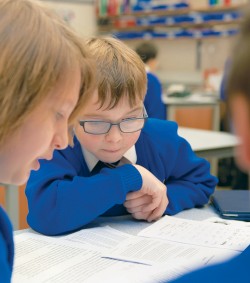Today you will…
Analyse a range of literary texts develop your speaking and listening skills create your own drama performance.
Group work: the kids love it, Ofsted love it, but all too often it falls flat on its face and we are left scratching our heads as to why. I’ve lost count of the number of times I’ve overheard colleagues saying, “The kids are just no good at working together” and consigning group work to the bin as yet another fad that will go away if we ignore it long enough. Yet outside of the classroom – on sports fields, in music rooms, on drama stages – the same students are working together and producing amazing results, largely because PE, music and drama teachers understand that effective group work is a skill that needs to be developed over time. But time is a luxury we don’t have, especially with a group of eager/freshfaced/tearful/stroppy/homicidal (delete as appropriate to your little darlings) year sevens staring up at us, wondering whether English at big school is going to be as much fun as it was in juniors…
Fortunately, there is a range of co-operative learning structures that provides a fast and effective way to get your new students to gel as a group. Dr Spencer Kagan has spent the last 40 years researching and developing these, all of which are based on PIES – Positive interpendence, Individual accountability, Equal participation, and Simultaneous interaction. In essence, what this means is that the structures are designed to ensure every student has to take part, make progress and develop the so-called ‘soft’ skills of communication and teamwork. The activities that follow can be tailored to a range of prose, drama and poetry texts, and as such can slot into any scheme of work for any age group.
Starter activity
First lessons, especially with year sevens, can be dry affairs, with teachers trotting out their lists of expectations, class rules and regulations, and so on and so forth… which is fine, if you want the students to walk out of the lesson thinking ‘So English is going to be just like everything else’. If you would rather get them moving around, meeting each other and working on their speaking and listening skills from minute one, try Mix-Pair- Share. Get the students to ‘mix’ by walking around the room until you call ‘pair’. When you say this students grab the person nearest them to discuss the question you have set them. This could be an icebreaker (‘Tell each other your hobbies and the best and worst thing about your summer holidays’) or something more learning-based. After 30-60 seconds call ‘mix’ and repeat the process one or more times. If you don’t have the space or the inclination to get students milling around, then try Find-the-Fiction. Each student on a table writes out three statements about themselves, one of which is false. The pupils then take turns sharing these statements with their team mates, who have to guess which (ideally wildly extravagant) claim is untrue.
Main activities

1. Poetry round table
One of the best ways to remove any anti-poetry prejudices is to make apparent the link between poems and song lyrics. Choose a song with interesting words (I use Pearl Jam’s ‘Jeremy’) and print them out on an A4 sheet. Give each student in a group of four a copy of the ‘poem’ (without telling them what it is or who it’s by) and ask them to read it in silence, after which the round table activity begins. Ask pupils, ‘Whose voice do you think we are hearing in the poem? What evidence do you have for this?’ Learners then take turns writing a single response to the question on a piece of paper, then passing it round the table. At the end of a round, you should have four contributions. You can then either invite groups to share their responses with each other, or with the class so you can question them to extend their thinking, or you can move onto a second question (‘What is the tone of the poem? Is the speaker angry, or happy, or sad? Why do you think this?’) and then a third (‘What do you think the poem might be about?’) When you have asked all the questions you want to ask and explored the students’ answers, play the video of your ‘poem’ and compare students’ views on the poet’s identity and the subject and tone of the piece. If you prefer not to use music, you can do the same activity with a video of a performance poet. This works particularly well if you have footage of an older student performing some of his or her own poetry, as it further breaks down prejudices and shows students that poetry is a credible means of creative expression.
2. Reduced Shakespeare company
This is a fantastic way to get students to really engage with the narrative of a prose or drama text and to develop their empathy with the characters. After you have finished reading a text, split the class into teams of four and set them the task of writing and performing the text in a Reduced Shakespeare Company style. Each student must play at least one character and speak a minimum of six lines, the play has to be at least two minutes long, and it must include all the key aspects of the story. If you want to differentiate the task, give each group a style to perform in. For example, if you are doing ‘The Hunger Games’, get one team to do it using only lines from the original text, while another changes the language and delivery to an ‘Eastenders’ style, another as LA gangsters, another as the royal family and so on. In addition to developing their speaking and listening and close reading abilities, this activity forces them to use high level thinking skills to dissect the plot and pull out the most salient parts. Once all groups have written and practised their plays, you can either get them to perform in front of the class or film them and have a playback, complete with your own ‘Oscars’ ceremony.

Home learning
Create a Facebook Page
Love it or hate it, the fact remains that 70% of our students live on Facebook and, crucially, do more reading and writing on there than they do anywhere else, so why not embrace it? Ask your students to design their own Facebook profile page complete with images, but do not stipulate any further than that. This will allow them to bring their artistic and/or ICT skills into play, further builds on the ‘getting to know you’ element of the starter activity, and is a nice way of creating a personalised wall display for your classroom.
Summary
If we get students into good group working habits from day one the benefits are enormous: pupils will be effectively leading the learning in the classroom and every individual will be actively involved. It is worth regularly mixing up your tables of four so that learners experience working with as many of their classmates as possible. Kagan has devised literally hundreds of structures, so it’s worth experimenting to find out which ones work best for your classes.
Info bar
Additional resources
For more on co-operative learning go to: kaganonline.com Pearl Jam Jeremy video: http://tinyurl.com/ykz74z6 Student poetry performance: http://tinyurl.com/cfpgh9b
About the expert
Steve Duffy is a Quality Assessor and English teacher at a large comprehensive school in Essex.









